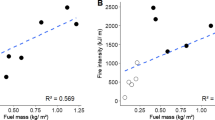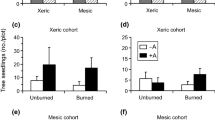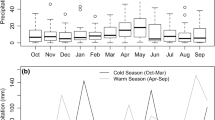Abstract
Plant invasions are a significant threat to fragmented native plant communities in many agricultural regions. Fire potentially facilitates invasions, but in landscapes historically subject to recurrent fires, exclusion of fire is also likely to result in loss of biodiversity. We investigated the relationship between fire, fragmentation and alien plant invasion in mallee communities of the Western Australian wheatbelt. We hypothesized that invasion is limited by lack of propagules and the low soil nutrient levels of this old, infertile landscape, but that fire and/or fragmentation disrupt these limits. We tested the effects of three factors on establishment and abundance of alien annuals: ± fire, ± post-fire seeding with the locally invasive Avena barbata (propagule availability) and three landscape contexts. The three landscape contexts, exploring site limitations, were reserve interiors, perimeter edges adjacent to agricultural land and internal reserve roadside edges. Our first hypothesis was supported: Avena establishment was consistently greater in seeded plots, but away from perimeter edges, growth was poor. Our second hypothesis was supported only for perimeter edges: neither fire nor fragmentation by interior roads enhanced invasive plant establishment or biomass. At perimeter edges, invasive plant biomass was significantly greater. This was associated with higher propagule availability and elevated soil nutrient levels but was not enhanced by fire. We conclude that fire is unlikely to promote invasion by alien annuals in low-nutrient ecosystems such as mallee, hence is a viable disturbance strategy for biodiversity conservation away from nutrient-enriched edges.




Similar content being viewed by others
References
Blair GJ, Chinoim N, Lefroy RB, Anderson GC, Crocker GJ (1991) A soil sulfur test for pasture and crops. Aust J Soil Res 29:619–626
Blank RR, Chambers J, Roundy B, Whittaker A (2007) Nutrient availability in rangelands soils: Influence of prescribed burning, herbaceous vegetation removal, overseeding with Bromus tectorum, season, and elevation. Rangel Ecol Manag 60:644–655
Bond W (1980) Fire and senescent fynbos in the Swartberg, Southern Cape. S Afr For J 114:68–71
Bond WJ, van Wilgen BW (1996) Fire and plants. Chapman and Hall, London
Bradstock RA, Cohn JS (2002) Fire regimes and biodiversity in semi-arid mallee ecosystems. In: Bradstock RA, Williams JE, Gill MA (eds) Flammable Australia: the fire regimes and biodiversity of a continent. Cambridge University Press, Cambridge, pp 238–258
Bureau of Meteorology [BOM] (2008) Climate data online. Bureau of Meteorology. http://www.bom.gov.au/climate/averages/. Accessed 12 Sep 2008
Cale P, Hobbs R (1991) Condition of roadside vegetation in relation to nutrient status. In: Saunders DA, Hobbs RJ (eds) Nature conservation 2: the role of corridors. Surrey Beatty and Sons, Chipping Norton, pp 353–362
Clarke KR, Gorley RN (2006) PRIMER v6: user manual/tutorial. PRIMER-E, Plymouth
Cochrane A, Monks L, Lally T (2007) Response of the germinable soil-stored seed bank of a remnant reserve in the southern Western Australia agricultural zone to smoke and fire treatment. J R Soc West Aust 90:47–52
Cox RD, Allen EB (2008) Composition of soil seed banks in southern California coastal sage scrub and adjacent exotic grassland. Plant Ecol 198:37–46
D’Antonio CM, Vitousek PM (1992) Biological invasions by exotic grasses, the grass/fire cycle, and global change. Ann Rev Ecol Syst 23:63–87
Davies KW, Sheley RL, Bates JD (2008) Does fall prescribed burning Artemisia tridentata steppe promote invasion or resistance to invasion after a recovery period? J Arid Environ 72:1076–1085
Duncan DH, Dorrough J, White M, Moxham C (2008) Blowing in the wind? Nutrient enrichment of remnant woodlands in an agricultural landscape. Landsc Ecol 23:107–119
Fowler JF, Hull Sieg C, Dickson BG, Saab V (2008) Exotic plant species diversity: Influence of roads and prescribed fire in Arizona Ponderosa Pine forests. Rangel Ecol Manag 61:284–293
Gelbard JL, Belnap J (2003) Roads as conduits for exotic plant invasions in a semiarid landscape. Conserv Biol 17:420–432
Groves RH, Di Castri F (1991) Biogeography of Mediterranean invasions. Cambridge University Press, Cambridge
Gundale MJ, Sutherland S, DeLuca TH (2008) Fire, native species, and soil resource interactions influence the spatio-temporal invasion pattern of Bromus tectorum. Ecography 31:201–210
Hansen MJ, Clevenger AP (2005) The influence of disturbance and habitat on the presence of non-native plant species along transport corridors. Biol Conserv 125:249–259
Hester AJ, Hobbs RJ (1992) Influence of fire and soil nutrients on native and non-native annuals at remnant vegetation edges in the Western Australian wheatbelt. J Veg Sci 3:101–108
Hobbs RJ, Atkins L (1988) Effect of disturbance and nutrient addition on native and introduced annuals in plant communities in the Western Australian wheatbelt. Aust J Ecol 13:171–179
Hobbs RJ, Atkins L (1991) Interactions between annuals and woody perennials in a Western Australian nature reserve. J Veg Sci 2:643–654
Hobbs RJ, Huenneke LF (1992) Disturbance, diversity, and invasion: implications for conservation. Conserv Biol 6:324–337
Hobbs RJ, Yates CJ (2003) Impacts of ecosystem fragmentation on plant populations: generalising the idiosyncratic. Aust J Bot 51:471–488
Hopper SD (2009) OCBIL theory: towards an integrated understanding of the evolution, ecology and conservation of biodiversity on old, climatically buffered, infertile landscapes. Plant Soil 322:49–86
Huenneke LF, Hamburg SP, Koide R, Mooney HA, Vitousek PM (1990) Effects of soil resources on plant invasion and community structure in Californian serpentine grassland. Ecology 71:478–491
Keeley JE (2006) Fire management impacts on invasive plants in the western United States. Conserv Biol 20:375–384
Lamont BB, Rees RG, Witkowski ETF, Whitten VA (1994) Comparative size, fecundity and ecophysiology of roadside plants of Banksia hookeriana. J Appl Ecol 31:137–144
Lenz TI, Facelli JM (2005) The role of seed limitation and resource availability in the recruitment of native perennial grasses and exotics in a South Australian grassland. Austral Ecol 30:684–694
Maher KA, Hobbs RJ, Yates CJ (2010) Woody shrubs and herbivory influence tree encroachment in the sandplain heathlands of southwestern Australia. J Appl Ecol 47:441–450
Milberg P, Lamont BB (1995) Fire enhances weed invasion of roadside vegetation in southwestern Australia. Biol Conserv 73:45–49
Neary DG, Klopatek CC, DeBano LF, Ffolliott PF (1999) Fire effects on belowground sustainability: a review and synthesis. For Ecol Manag 122:51–71
Orians GH, Milewski AV (2007) Ecology of Australia: the effects of nutrient-poor soils and intense fires. Biol Rev 82:393–423
Parsons BC, Gosper CR (in press) Contemporary fire regimes in a fragmented and an unfragmented landscape: implications for vegetation structure and persistence of the fire-sensitive malleefowl. Int J Wildland Fire (in press)
Paterson JG, Goodchild NA, Boyd WJR (1976) Effect of storage temperature, storage duration and germination temperature on the dormancy of seed of Avena fatua L. and Avena barbata Pott ex Link. Aust J Agric Res 27:373–379
Pickett STA, White PS (eds) (1985) The ecology of natural disturbance and patch dynamics. Academic Press, Orlando
Prober SM, Thiele KR, Lunt ID (2002) Identifying ecological barriers to restoration in temperate grassy woodlands: soil changes associated with different degradation states. Aust J Bot 50:699–712
Prober S, Taylor S, Edwards R, Mills B (2009) Effectiveness of repeated autumn and spring fires for understorey restoration in weed-invaded temperate eucalypt woodlands. Appl Veg Sci 12:440–450
Quinn GP, Keough MJ (2002) Experimental design and data analysis for biologists. Cambridge University Press, Cambridge
Rayment GE, Higginson FR (1992) Australian laboratory handbook of soil and water chemical methods. Inkata Press, Melbourne
Rodríguez A, Durán J, Fernández-Palacios JM, Gallardo A (2009) Short-term wildfire effects on the spatial pattern and scale of labile organic-N and inorganic-N and P pools. For Ecol Manag 257:739–746
Ross KA, Fox BJ, Fox MD (2002) Changes to plant species richness in forest fragments: fragment age, disturbance and fire history may be as important as area. J Biogeogr 29:749–765
SAS Publishing (2004) SAS/STAT 9.1 User’s guide, vol 1–7. SAS Publishing, Cary
Seabloom EW, Harpole WS, Reichman OJ, Tilman D (2003) Invasion, competitive dominance, and resource use by exotic and native Californian grassland species. Proc Natl Acad Sci USA 100:13384–13389
Searle PL (1984) The berthelot or indophenol reaction and its use in the analytical chemistry of nitrogen. A review. Analyst 109:549–568
Shedley E (2007) Fire and biodiversity guidelines for the Avon Basin. Avon Catchment Council and the Department of Environment and Conservation, Narrogin
Smith MA, Bell DT, Loneragan WA (1999) Comparative seed germination ecology of Austrostipa compressa and Ehrharta calycina (Poaceae) in a Western Australian Banksia woodland. Aust J Ecol 24:35–42
Specht RL (1969) A comparison of the sclerophyllous vegetation characteristic of Mediterranean type climates in France, California and Southern Australia II. Dry matter, energy and nutrient accumulation. Aust J Bot 17:293–308
Standish RJ, Cramer VA, Hobbs RJ (2008) Land-use legacy and the persistence of invasive Avena barbata on abandoned farmland. J Appl Ecol 45:1576–1583
Systat Software Inc (2006) Sigmaplot 10.0. www.systat.com
Tanentzap AJ, Bazely DR (2009) Propagule pressure and resource availability determine plant community invasibility in a temperate forest understorey. Oikos 118:300–308
Thomson VP, Leishman MR (2005) Post-fire vegetation dynamics in nutrient-enriched and non-enriched sclerophyll woodland. Austral Ecol 30:250–260
Trombulak SC, Frissell CA (2000) Review of ecological effects of roads on terrestrial and aquatic communities. Conserv Biol 14:18–30
Turnbull LA, Crawley MJ, Rees M (2000) Are plant populations seed-limited? A review of seed sowing experiments. Oikos 88:225–238
Varner JM, Gordon DR, Putz FE, Hiers JK (2005) Restoring fire to long-unburned Pinus palustris ecosystems: novel fire effects and consequences for long-unburned ecosystems. Restor Ecol 13:536–544
von der Lippe M, Kowarik I (2007) Long distance dispersal of plants by vehicles as a driver of plant invasions. Conserv Biol 21:986–996
Withers J, Ashton DH (1977) Studies on the status of unburnt Eucalyptus woodland at Ocean Grove, Victoria. 1 The structure and regeneration. Aust J Bot 25:623–627
Yates CJ, Ladd PG (2005) Relative importance of reproductive biology and establishment ecology for persistence of a rare shrub in a fragmented landscape. Conserv Biol 19:239–249
Yates CJ, Hobbs RJ, Bell RW (1994) Landscape disturbances and regeneration in semi-arid woodlands of south-western Australia. Pac Conserv Biol 1:214–221
Yates CJ, Hopper S, Brown A, van Leeuwen S (2003) Impact of two wildfires on endemic granite outcrop vegetation in Western Australia. J Veg Sci 14:185–194
Acknowledgments
We thank Mitchell Davies and Department of Environment and Conservation (DEC) fire crews for organizing and conducting the prescribed burns. Brett Beecham, Mitchell Davies, Steve Gorton, Graeme Keals and Peter Lacey (DEC) provided helpful comments on the experimental proposal, Steven Zabar (CSIRO Ecosystem Sciences—CES) and Tanya Llorens (DEC) provided field and lab assistance respectively, and A/Professor John Henstridge of Data Analysis Australia and Dr Jane Speijers of the Biometrics Unit, Western Australian Department of Agriculture and Food, provided advice and assistance with data analysis. This research was conducted under DEC Licenses SW011589 and CE001774. Roger Lawes, Yvonne Buckley (CES) and an anonymous referee provided helpful comments on drafts of the manuscript.
Author information
Authors and Affiliations
Corresponding author
Rights and permissions
About this article
Cite this article
Gosper, C.R., Yates, C.J., Prober, S.M. et al. Fire does not facilitate invasion by alien annual grasses in an infertile Australian agricultural landscape. Biol Invasions 13, 533–544 (2011). https://doi.org/10.1007/s10530-010-9847-z
Received:
Accepted:
Published:
Issue Date:
DOI: https://doi.org/10.1007/s10530-010-9847-z




